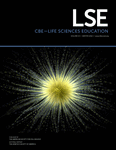Implementation of a Collaborative Series of Classroom-Based Undergraduate Research Experiences Spanning Chemical Biology, Biochemistry, and Neurobiology
Abstract
Classroom undergraduate research experiences (CUREs) provide students access to the measurable benefits of undergraduate research experiences (UREs). Herein, we describe the implementation and assessment of a novel model for cohesive CUREs focused on central research themes involving faculty research collaboration across departments. Specifically, we implemented three collaborative CUREs spanning chemical biology, biochemistry, and neurobiology that incorporated faculty members’ research interests and revolved around the central theme of visualizing biological processes like Mycobacterium tuberculosis enzyme activity and neural signaling using fluorescent molecules. Each CURE laboratory involved multiple experimental phases and culminated in novel, open-ended, and reiterative student-driven research projects. Course assessments showed CURE participation increased students’ experimental design skills, attitudes and confidence about research, perceived understanding of the scientific process, and interest in science, technology, engineering, and mathematics disciplines. More than 75% of CURE students also engaged in independent scientific research projects, and faculty CURE contributors saw substantial increases in research productivity, including increased undergraduate student involvement and academic outputs. Our collaborative CUREs demonstrate the advantages of multicourse CUREs for achieving increased faculty research productivity and traditional CURE-associated student learning and attitude gains. Our collaborative CURE design represents a novel CURE model for ongoing laboratory reform that benefits both faculty and students.



